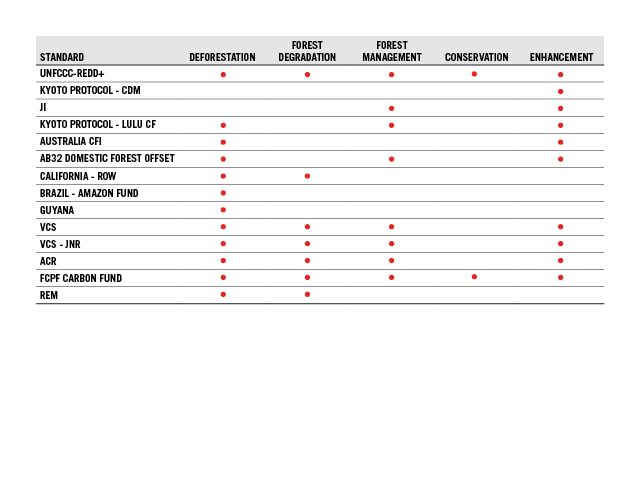Scope
Overview
For the purposes of this webpage, scope refers to the categories or activities that are eligible or required for inclusion in the system. Standards and initiatives define the scope of eligible forest-related activities in different ways. For the purposes of the REDD+ Markets pages, we have included the following forest categories/activities (where enhancement is assumed to include afforestation and reforestation) based on the breakdown of REDD+ under the UNFCCC and the variety of ways standards have disaggregated the scope of eligible activities: deforestation, forest management, degradation, conservation, and enhancement.
The Kyoto Protocol requires mandatory inclusion of afforestation, reforestation, deforestation, and forest management for Annex I Parties’ accounting. Under the Protocol’s Clean Development Mechanism, however, only afforestation and reforestation are eligible. In contrast, the UNFCCC’s Cancun Agreement explicitly named five activities comprising REDD+: (1) reducing emissions from deforestation; (2) reducing emissions from forest degradation; (3) conservation of forest carbon stocks; (4) sustainable management of forests; and (5) enhancement of forest carbon stocks. Many consider enhancement to include afforestation and reforestation, and the latter 3 activities together as the “plus” in REDD+. Of these activities, conservation is the only one without precedent. Conservation activities are generally considered emissions neutral as they preserve a status quo; in some existing standards, conservation activities would only qualify if the forest within the boundaries of the activity is under threat, in which case a projected or business-as-usual baseline would be constructed and the conservation project would fall under avoided deforestation or degradation.
All countries are requested to submit information on national inventories of greenhouse gas emissions to the UNFCCC using IPCC Guidelines. The five REDD+ activities (as listed above) do not map one-to-one into such Guidelines, which have several forest-related reporting categories including: (1) “forests remaining forests” which would include sustainable management of forests, forest degradation, and possibly also carbon stock enhancement; (2) “other lands converted to forests”, which could include enhancement of forest carbon stock; and (3) “forests converted to other lands”, or deforestation.
Many developing countries are choosing to start with deforestation (e.g. Brazil, Guyana), in some cases with the intent to add forest degradation when systems are available to accurately measure degradation. However, for other countries forest degradation (e.g. the Democratic Republic of the Congo) and/or the enhancement of forest carbon stock (e.g. Costa Rica) has the highest mitigation potential, and therefore such countries must consider including more than just deforestation, even as an initial step.
Voluntary carbon standards and domestic systems that accept project offsets tend to have a pre-determined list of eligible activities, and to register a project, such activities must have validated methodologies.
The table below shows the scope of the different standards that are analysed on the REDD Desk.



 Twitter
Twitter Google+
Google+ Facebook
Facebook LinkedIn
LinkedIn Digg
Digg del.icio.us
del.icio.us StumbleUpon
StumbleUpon